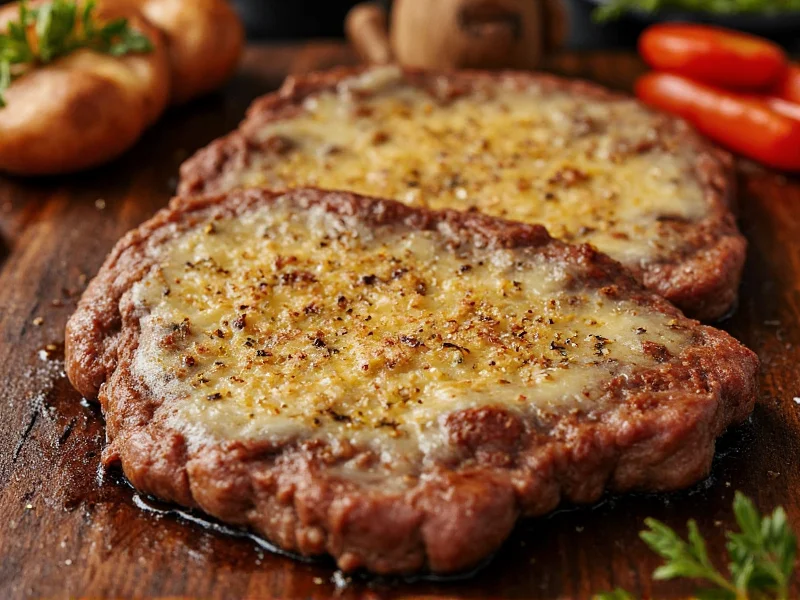Creating the perfect steak and cheese seasoning requires understanding how each component contributes to the final flavor profile. Unlike generic steak rubs, this specialized blend must work harmoniously with both meat and cheese while maintaining the delicate balance that defines a great cheesesteak. Many commercial blends contain unnecessary fillers, but crafting your own ensures freshness and control over ingredients.
Essential Components of Steak and Cheese Seasoning
The magic of steak and cheese seasoning lies in its simplicity. Each ingredient serves a specific purpose in creating that signature taste associated with Philadelphia-style cheesesteaks. Understanding these roles helps you adjust the blend to your preference while maintaining authenticity.
| Ingredient | Function | Recommended Amount |
|---|---|---|
| Coarse sea salt | Enhances natural meat flavors and draws out moisture | 2 parts |
| Garlic powder | Provides savory depth without burning | 1.5 parts |
| Onion powder | Creates sweet umami foundation | 1.5 parts |
| Paprika (sweet) | Adds color and subtle sweetness | 1 part |
| Freshly ground black pepper | Contributes mild heat and complexity | 0.75 parts |
Classic Homemade Steak and Cheese Seasoning Recipe
Creating authentic steak and cheese seasoning from scratch takes just minutes and yields significantly better results than store-bought alternatives. This basic recipe serves as your foundation for restaurant-quality cheesesteaks at home.
Basic Blend Ingredients
- ¼ cup coarse sea salt
- 3 tablespoons garlic powder
- 3 tablespoons onion powder
- 2 tablespoons sweet paprika
- 1½ tablespoons freshly ground black pepper
- 1 tablespoon dried oregano (crushed between fingers)
- 1½ teaspoons cayenne pepper (optional for heat)
Preparation Method
- Combine all ingredients in a medium bowl
- Whisk thoroughly for 2-3 minutes to ensure even distribution
- Sift through a fine mesh strainer to eliminate clumps
- Transfer to an airtight container away from light and moisture
- Allow flavors to meld for 24 hours before first use
Advanced Variations for Specialized Preferences
Once you've mastered the classic blend, consider these professional variations that address specific flavor preferences while maintaining the essence of authentic steak and cheese seasoning.
Smoky Version
Replace 1 tablespoon of sweet paprika with smoked paprika and add ½ teaspoon ground cumin. This variation works exceptionally well with ribeye cuts and provolone cheese, creating a deeper flavor profile reminiscent of grilled cheesesteaks.
Low-Sodium Alternative
Reduce salt to 2 tablespoons and increase garlic powder and onion powder by 1 tablespoon each. Add 1 teaspoon mushroom powder for enhanced umami. This version maintains flavor complexity while significantly reducing sodium content—ideal for those monitoring salt intake without sacrificing taste.
Spicy Arrabbiata Style
Increase cayenne to 1 teaspoon and add ½ teaspoon crushed red pepper flakes plus ¼ teaspoon dried thyme. This Italian-inspired variation pairs perfectly with hot peppers and works beautifully with Cheez Whiz or American cheese for a bold, restaurant-style experience.
Proper Application Techniques
How you apply steak and cheese seasoning matters as much as the blend itself. Many home cooks make the mistake of treating it like a dry rub for grilled steaks, but cheesesteak preparation requires different handling.
For authentic results: Apply seasoning after thinly sliced steak begins to cook. Wait until the meat has released some moisture on the griddle, then sprinkle seasoning evenly across the surface. Use a flat-top spatula to incorporate the seasoning into the meat as it cooks, allowing flavors to penetrate without creating a hard crust. This technique ensures the seasoning integrates with the meat juices rather than burning on the surface.
When preparing homemade steak and cheese seasoning for meal prep, remember that refrigerated cooked steak absorbs flavors differently than freshly cooked. For best results with pre-cooked steak, reduce seasoning quantity by 25% and add a splash of Worcestershire sauce during reheating to reactivate flavors.
Storage and Shelf Life Guidelines
Proper storage maintains your steak and cheese seasoning's potency and prevents flavor degradation. Unlike single-ingredient spices, blends lose complexity at different rates due to varying moisture contents.
Store in an airtight glass container away from heat and light. The ideal container size should minimize air space—use smaller containers as the blend gets used up. Properly stored, your homemade steak and cheese seasoning maintains peak flavor for 4-6 months. After this period, while still safe to use, the delicate balance of flavors begins to shift as volatile compounds evaporate at different rates.
Never store seasoning blends in refrigerator humidity, as this accelerates flavor loss and promotes clumping. If your blend develops hard clumps or loses its characteristic aroma, it's time to make a fresh batch.
Common Mistakes to Avoid
Even experienced cooks make these critical errors when preparing steak and cheese seasoning that compromise authentic flavor:
- Using fine table salt instead of coarse salt - Fine salt dissolves too quickly, creating uneven seasoning and potentially over-salted spots
- Adding liquid ingredients to the dry blend - This creates spoilage risks and alters the seasoning's application properties
- Applying seasoning too early in cooking - Causes burning and bitter flavors rather than proper flavor integration
- Using pre-ground pepper instead of freshly ground - Loses 70% of its volatile compounds within hours of grinding
- Storing in clear containers - Light exposure degrades paprika's flavor compounds within weeks
Troubleshooting Flavor Issues
If your steak and cheese seasoning isn't delivering restaurant-quality results, these adjustments can rescue your blend:
Problem: Seasoning burns quickly on the griddle
Solution: Reduce paprika content by 25% and ensure you're applying after the steak has released some moisture
Problem: Flavor disappears once cheese is added
Solution: Increase garlic powder by 10% and add ½ teaspoon monosodium glutamate (MSG) to boost umami that cuts through cheese richness
Problem: Too much heat overwhelms other flavors
Solution: Replace cayenne with Aleppo pepper flakes for more complex, less aggressive heat











 浙公网安备
33010002000092号
浙公网安备
33010002000092号 浙B2-20120091-4
浙B2-20120091-4